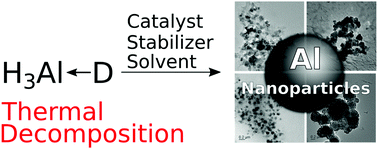Aluminum nanoparticle preparation via catalytic decomposition of alane adducts – influence of reaction parameters on nanoparticle size, morphology and reactivity†
Abstract
Al nanoparticles represent one of the most challenging classes of metal nanoparticles in synthesis and handling due to their high chemical reactivity and their affinity to oxidation. A promising wet chemical preparation route is the catalytic decomposition of alane adducts. In the current systematic study, we investigated the influence of various reaction parameters, such as precursors, catalysts, solvents, reaction temperatures, capping agents, and concentrations of the reactants on the size and morphology of the resulting Al nanoparticles. One major goal was the optimization of the reaction parameters towards short reaction times. Our studies revealed that Ti alkoxides, such as Ti(OiPr)4, are much more efficient decomposition catalysts compared to other related metal catalysts. Optimized conditions for full conversion times smaller than 15 min are temperatures between 90–100 °C and non-polar solvents such as toluene. Amine alanes containing short alkyl chains, for example H3AlNMe2Et or H3AlNEt3, were the most suitable precursors, leading to the formation of the smallest nanoparticles. The use of weakly coordinating capping agents like amines and phosphines should be preferred over the commonly employed carboxylic acids because they do not accelerate the formation of an amorphous oxide shell upon binding to the particle surface. In conclusion, the best reaction parameters for a fast synthesis of Al nanoparticles via a catalytic decomposition approach are the combination of sterically less hindered amine alanes applying a Ti catalyst in toluene solutions in the presence of amine or phosphine stabilizers at elevated temperatures.



 Please wait while we load your content...
Please wait while we load your content...